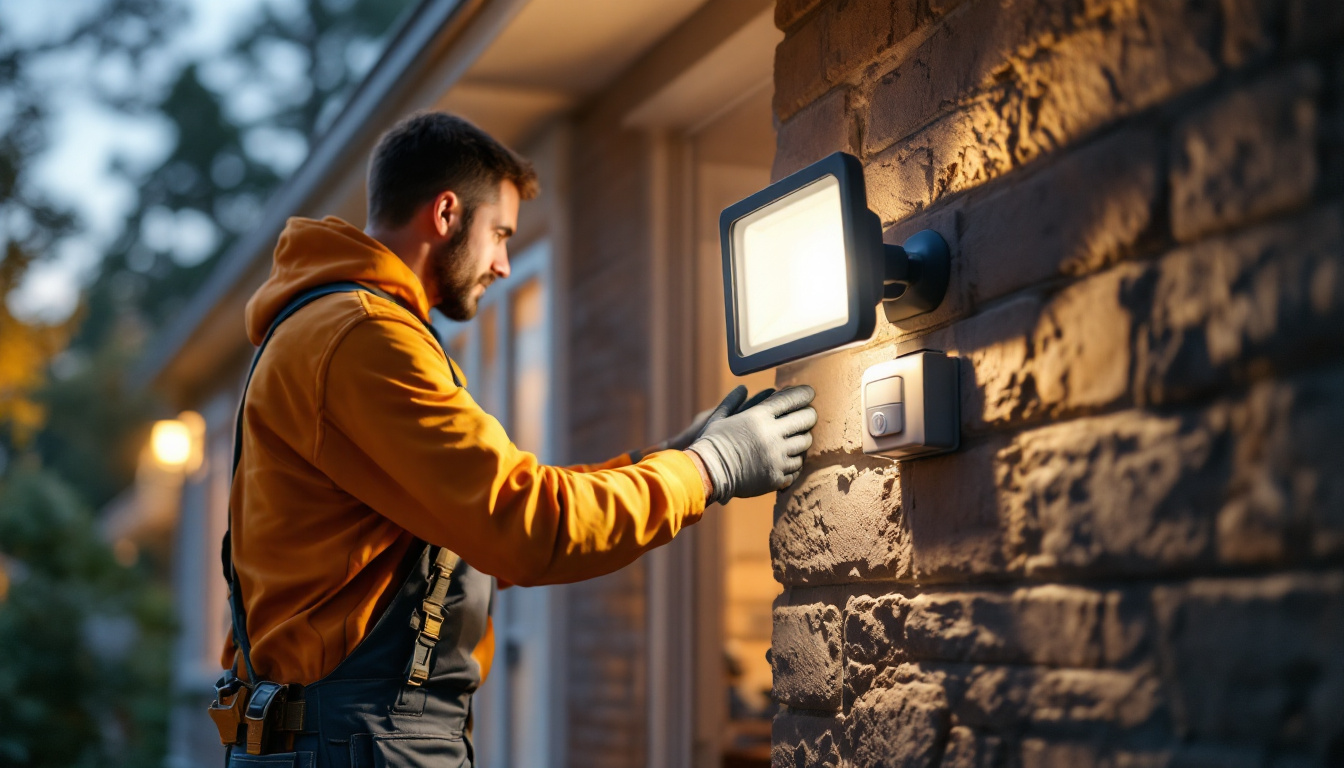
Lighting is a crucial aspect of any garage or workshop space, impacting both functionality and safety. For lighting contractors, understanding the best practices for selecting and installing shop garage lights can significantly enhance the quality of their work and ensure customer satisfaction. This article delves into essential considerations, types of lighting, installation tips, and maintenance practices that every lighting contractor should know.
Proper lighting in a garage or workshop not only improves visibility but also enhances safety and productivity. A well-lit space allows for more precise work, reduces the risk of accidents, and creates a more inviting atmosphere for users. Furthermore, the right lighting can highlight specific areas, making tasks easier and more efficient. Additionally, the aesthetic appeal of a well-lit garage can transform it from a mere storage space into a functional and enjoyable environment, encouraging users to spend more time on their projects.
One of the primary reasons for investing in quality garage lighting is safety. Poorly lit areas can lead to accidents, injuries, and damage to tools and vehicles. By ensuring that every corner of the garage is adequately illuminated, contractors can help their clients avoid potential hazards. This includes using lights that minimize shadows and provide even illumination across the workspace. Moreover, incorporating motion-sensor lights can further enhance safety by automatically illuminating the space when someone enters, reducing the risk of stumbling in the dark. It is also beneficial to consider the placement of lights; overhead fixtures can provide general illumination, while task lights can be directed toward specific work areas, ensuring that every task is performed under optimal conditions.
In a workshop setting, productivity is key. Adequate lighting can significantly enhance a worker’s ability to focus on tasks, reducing eye strain and fatigue. When selecting lights, contractors should consider the color temperature and brightness, as these factors can influence a worker’s mood and efficiency. Bright, white light often mimics daylight, which can be beneficial for detailed work. Additionally, the use of adjustable lighting options, such as dimmable LED fixtures, allows workers to customize the brightness according to their specific needs, whether they are performing intricate repairs or general maintenance. This flexibility not only fosters a more comfortable working environment but also encourages creativity, as workers feel more energized and engaged in their projects. Furthermore, integrating natural light sources, such as windows or skylights, can complement artificial lighting and create a more dynamic workspace, enhancing both mood and productivity.
Choosing the right type of lighting is crucial for achieving optimal results. Various options are available, each with its unique benefits and applications. Understanding these types can help contractors make informed decisions that best suit their clients’ needs.
Fluorescent lights are a popular choice for garages due to their energy efficiency and bright illumination. They provide a wide range of color temperatures, allowing contractors to select the most suitable option for the workspace. Additionally, fluorescent lights have a long lifespan, making them a cost-effective solution for clients. They are particularly effective in larger spaces, as they can cover extensive areas without the need for multiple fixtures. Moreover, advancements in technology have led to the development of slimline fluorescent tubes, which can fit into tighter spaces and provide a sleek, modern look.
LED lights have gained popularity in recent years, and for good reason. They are highly energy-efficient, have a long lifespan, and produce minimal heat compared to traditional bulbs. Moreover, LED lights come in various styles and brightness levels, making them versatile for different garage applications. Their ability to provide instant brightness and dimming options further enhances their appeal. Additionally, many LED fixtures are now equipped with smart technology, allowing homeowners to control their lighting remotely via smartphone apps. This feature not only adds convenience but also enables users to customize their garage lighting based on specific tasks or moods, further enhancing the functionality of the space.
Halogen lights offer a bright, white light that closely resembles natural daylight. They are ideal for detailed tasks where precision is essential. However, they do generate more heat and consume more energy compared to LED and fluorescent options. Contractors should weigh the pros and cons when recommending halogen lighting to clients. Despite their higher energy consumption, halogen lights are often favored for their excellent color rendering capabilities, making them suitable for spaces where accurate color perception is important, such as in a workshop or for automotive repairs. Additionally, halogen bulbs can be easily dimmed, allowing for greater control over the ambiance and brightness in the garage, which can be particularly useful during different times of the day or for various activities.
Designing an effective lighting layout requires careful planning and consideration of various factors. Contractors should assess the specific needs of the workspace, including the tasks performed and the size of the garage.
Before selecting lights, it is essential to evaluate the garage’s dimensions and layout. This includes measuring the ceiling height, identifying potential obstructions, and determining the areas that require the most illumination. A well-thought-out lighting plan should address these factors to ensure even distribution of light throughout the space. Additionally, understanding the natural light sources available, such as windows or skylights, can help in balancing artificial lighting with daylight, reducing energy consumption and creating a more inviting atmosphere.
Layering light involves using a combination of ambient, task, and accent lighting to create a well-rounded illumination scheme. Ambient lighting provides overall illumination, while task lighting focuses on specific areas where detailed work is performed. Accent lighting can highlight features or create a particular atmosphere. By incorporating all three layers, contractors can enhance the functionality and aesthetics of the garage. For example, using LED strip lights under shelves can provide both task and accent lighting, illuminating work surfaces while adding a modern touch to the design. This thoughtful layering not only improves visibility but can also enhance the overall mood of the space, making it more enjoyable to work in.
Incorporating dimmers and lighting controls can significantly improve the user experience. Dimmers allow for adjustable brightness levels, enabling users to customize the lighting according to their needs. Smart lighting controls can also enhance convenience, allowing users to manage their lighting remotely or set schedules for automated operation. These features can be particularly appealing to clients looking for modern solutions. Furthermore, integrating motion sensors can provide an additional layer of functionality, ensuring that lights are activated only when the space is in use, thus promoting energy efficiency. This combination of smart technology and user-friendly controls not only enhances the practicality of the garage but also aligns with contemporary trends in home automation, making the space more adaptable to various activities and preferences.
Proper installation is critical to ensuring that the lighting system functions effectively and safely. Lighting contractors should adhere to best practices during the installation process to avoid common pitfalls.
Every region has specific electrical codes and regulations that must be followed during installation. Contractors should familiarize themselves with these requirements to ensure compliance and avoid potential legal issues. Adhering to local codes not only ensures safety but also enhances the contractor’s reputation as a professional.
The positioning of lights plays a crucial role in their effectiveness. Contractors should strategically place fixtures to minimize shadows and maximize coverage. This may involve installing lights at varying heights and angles to achieve the desired illumination. Additionally, ensuring that lights are not obstructed by shelves or equipment is essential for maintaining optimal performance.
Once the installation is complete, it is vital to test the lighting system thoroughly. This includes checking for any flickering, uneven illumination, or dead spots. Adjustments may be necessary to achieve the best results. Taking the time to fine-tune the lighting can lead to a more satisfied client and a job well done.
Regular maintenance is essential to prolong the lifespan of garage lighting and ensure continued performance. Contractors should educate their clients on proper care and maintenance practices.
Dust and dirt can accumulate on lighting fixtures, diminishing their effectiveness over time. Contractors should advise clients to clean fixtures regularly to maintain optimal brightness. This can be as simple as wiping down surfaces with a damp cloth or using specific cleaning solutions for more stubborn grime.
When bulbs burn out, it is important to replace them promptly to maintain adequate lighting levels. Contractors should recommend keeping spare bulbs on hand to ensure that clients can quickly replace any burned-out fixtures. This proactive approach can prevent disruptions in workflow and enhance safety.
Encouraging clients to conduct regular inspections of their lighting systems can help identify potential issues before they become significant problems. This includes checking for flickering lights, unusual sounds, or signs of wear and tear. Addressing these issues early can save time and money in the long run.
In conclusion, lighting contractors play a vital role in enhancing the functionality and safety of garages and workshops through effective lighting solutions. By understanding the importance of proper garage lighting, familiarizing themselves with various types of lights, and adhering to best practices for design, installation, and maintenance, contractors can provide exceptional service to their clients.
Ultimately, investing time and effort into mastering these aspects of garage lighting will not only improve the quality of work but also foster long-term relationships with clients. As the demand for well-lit workspaces continues to grow, contractors who prioritize these best practices will stand out in a competitive market.
Ready to elevate your lighting projects with the best in the business? Look no further than LumenWholesale for all your shop garage lighting needs. We provide lighting contractors with the highest quality, spec-grade lighting products at prices that can’t be beaten. With our direct-to-contractor approach, you’ll enjoy superior products without the extra costs. Our wide selection is designed to meet rigorous industry standards, ensuring that your projects shine with reliability and performance. Plus, with free shipping on bulk orders, you can stock up on premium lighting without worrying about hidden fees or compromises. Don’t settle for less—choose LumenWholesale for Wholesale Lighting at the Best Value and make every workspace a beacon of productivity and safety.

Discover how lighting flowers can provide a competitive advantage for lighting contractors.

Discover how choosing the right power supply cord can give lighting contractors a competitive edge.

Discover how lighting contractors can enhance their services and boost client satisfaction with motion detector flood lights.

Discover the transformative impact of LED string outdoor lights for lighting contractors.